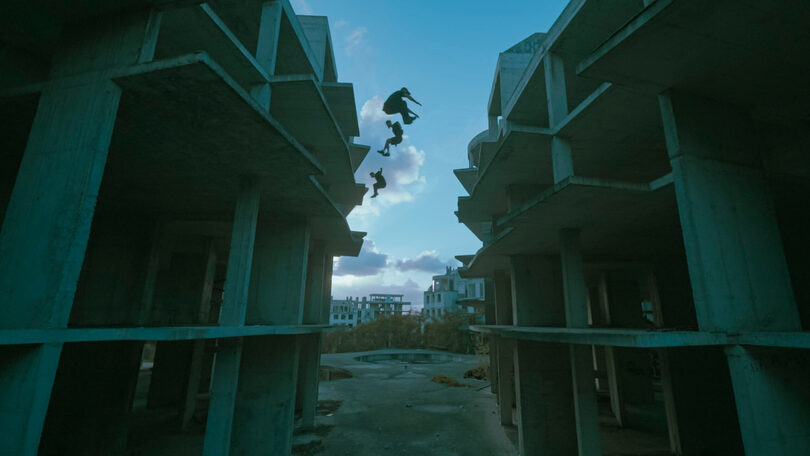Michael Bay’s ‘We are Storror’ stuns with thrilling parkour sequences

Michael Bay’s “We Are Storror” portrays the life and times of the British parkour group Storror. The documentary uses footage from old youtube videos as well as drone shots under Bay’s instruction. Courtesy of South by Southwest Festival
Get the latest Syracuse news delivered right to your inbox.
Subscribe to our newsletter here.
You only have two strikes or you’re dead. That’s how Michael Bay used a baseball analogy to describe parkour.
Bay’s first feature-length documentary, “We Are Storror,” depicts the life and times of the British parkour group Storror. The film portrays the life-and-death stakes of parkour, an activity these seven men have dedicated their lives to.
It’s a perfect match between activity and filmmaker. Both parkour and Bay’s films feature a heavy dose of maximalism and fast-paced, sometimes totally incoherent, action sequences. It’s nearly all instinctual. Sometimes, logic has to go by the wayside in order to survive.
But the true magic of this film, which premiered at the 2025 South by Southwest Festival, comes not from showing the rise of Storror or their amazing parkour stunts (though it’s still pretty exhilarating). Rather, “We Are Storror” questions what one will do for an art form and what happens when an artist is running out of time to fulfill their potential.
The documentary wastes no time showing the excitement and danger of parkour. A montage of the seven group members jumping down a zigzagging staircase next to a dam abruptly ends when a close friend of the group gets seriously injured by landing on the stone surface. The matter-of-fact nature of the friend’s fall in the footage feels terrifying, and the film doesn’t shy away from showing off graphic injuries.
The accident sends Storror into a state of worry and reflection. Now that they’re all into their 30s and have other loved ones, they have to consider how many more parkour feats they can do. While they gleefully boast about choosing parkour over romance, they start to feel a sense of longing and connection that their sport cannot satisfy.
“We are Storror” additionally reveals how each of the members is distinct. Parkour doesn’t mean the exact same thing to each member of the group. While some feel it can be a form of artistic expression emphasizing rebellion, others find it to be a high-intensity sport, requiring precision to stay alive. Although Bay described it as a sport and Storror as a group of athletes, the documentary doesn’t provide answers to these questions.
With all of the inquisitions into the high-stakes world of parkour, the biggest question remains — who on earth would want to do this and why would anyone watch a documentary about it from the man who made “Transformers?”
The simple answer is so that we understand the ecstatic thrill parkour can produce.
Along with using plenty of archival footage from Storror’s YouTube videos, Bay and his team of drone cameras perfectly track the movements and leaps between buildings. This is where we can truly understand the perfect mishmash between Bay and parkour.
Bay, who masterfully used drone shots in his 2022 film “Ambulance,” has a clear knowledge of how to move a drone and add meaning to the action. But there’s one caveat that comes with his documentary; Bay, a member of the Directors Guild of America, could not be on set when Storror was doing their acts unless he wanted to face DGA and their legal repercussions. Since he couldn’t fully guarantee their safety while pursuing the life-or-death activity, Bay could only give instructions on shooting days.
This may seem like a hindrance and take away any of the stylings that make Bay so distinct as a director. But he more than makes up for his on-set absence in the editing. The sprinting and jumping between abandoned buildings has the rapid cuts that Bay endearingly, and sometimes frustratingly, uses in all of his movies. While the more climactic and suspenseful jumps come from Storror’s old YouTube videos, Bay uses the music and editing to establish classic cinematic tension and payoff.
The combination of Bay and Storror genuinely creates a sense of reward and gives the audience an inkling of why this parkour group does what it does and their hesitancy to say goodbye to it. The film, which still doesn’t have distribution, deserves attention and an IMAX theatrical run for its truly heart-pounding action sequences that serve as one of Bay’s best works yet (shockingly without explosions). But above all else, Bay gives a powerful examination of an artist’s relationship to their art.






